A long siding solely for domestic and minor industrial coal supplied was virtually a standard feature of almost every goods yard. Often the coal siding was run into a separate area owned or leased by one or more local traders, in built up areas the coal yard was often separate from the main goods yard. Local coal merchants often also traded as builders merchants, in which case they would have a separate area to store their goods either in the railway company yard or in a private yard close by, possibly served by a separate siding. The coal merchant might be a sole local trader with a single horse drawn wagon of his own or he might operate a fleet of vehicles driven by two-man teams hired for the work. A small country coal yard would receive perhaps three or four wagon loads a week, a yard serving a built up area might get through ten wagon loads a day.
The office of the coal merchant would be close by the entrance to the yard, so potential customers did not have to negotiate the dirty and dangerous yard area (to which the railways would object). At my local town yard there were four or five coal merchants all operating from one yard, they each had an office and these formed a row, replacing a section of fencing, so customers could step in directly from the pavements (a rear door gave the merchant access to the yard itself).
Having said which the merchant might have an office on the local high street, so the yard office was not dealing with customers, however there were also more prosaic reasons for locating the office by the yard entry, the merchant had to keep an eye on what his men were up to. Coal was usually loaded directly from the rail wagons onto the carts or lorries of the coal merchant as this reduced the amount of handling required. If the merchant was a sole operator he would take his vehicle in to the yard to load, but where there were men employed to do the work the carts or lorries would first be weighed-in on a weigh-bridge, then after loading they would be weighed-out again to check the load tallied. One dodge was to wash down the lorry before turning up to load, so when it went over the weigh-bridge inwards it had some additional weight of water on board. The water dripped and dried during loading so when they went out they actually had more coal loaded than was indicated. Sometimes the lads would turn up with perhaps five sacks, which they claimed were 'left on board from the previous day', the trader had to check these sacks as they might be full of bricks and rubble.
Having said all of which some traders had separate yards with no direct railway connection, in the town where I now live one trader used to collect his coal (carried in his own wagons) from the coal yard using a horse drawn tip cart. This was taken to his own yard, about a quarter of a mile away, where it was tipped ready for bagging. The bags then had to be loaded onto his delivery cart and carried to the customers storage bunker at the receiving end. Being a coal merchant was never a job for the faint hearted.
The main trade for a local merchant was domestic coal delivered in heavy hessian sacks, in 1970 over two thirds of British homes were still using solid fuel (although many had gas or electric heaters) and few homes used coal for cooking. Coal sacks were not black but a dark grey-brown with darker patches where they were stained by the coal dust. Nylon sacks were introduced in the 1970's but I am not sure what colour they were. A sack would typically last about a year, possibly two if treated with creosote. The creosote treated sacks were still not as black as the coal they contained (at least not after a couple of weeks in service) but they were darker than the untreated sacks.
The standard hundredweight coal sack was a proper official 'measure' and carried a small silver disk to indicate it's size. A hundredweight is 112 pounds or just under 51Kg, twenty hundredweight make a British (or 'long') ton. A simple scale was supplied on the delivery vehicle to get the weight right and a weights and measures inspector would typically allow a short-fall of a couple of pounds weight maximum per sack. One man would hold the sack, its bottom resting on the scale, whilst the second man would shovel coal. If the manpower was available two men did the shovelling and using big shovels (size 10 or even a size 12) five shovel fulls would fill the sack. The scale would then drop to indicate the load was correct.
Larger sacks were supplied to carry coke as this weighs less but was still sold by the hundredweight (the coke from the gas works was sold as Firemax after Nationalisation of the gas industry). After filling the sacks were stacked on the lorry, the tops of the sacks were not closed in any way but tended to form a more or less oval shape when filled with the coal or coke clearly visible inside. Coal sacks were commonly stacked two-deep on the lorry but if you did this with the coke sacks the top row was getting a bit high to reach (the coke sacks were something over five feet tall when loaded). The photograph at the bottom of this illustration shows the lorry operated by my local coal merchant in 2006, note the rotating yellow light mounted on the roof.
Fig___ Coal and coke loads on delivery vehicles
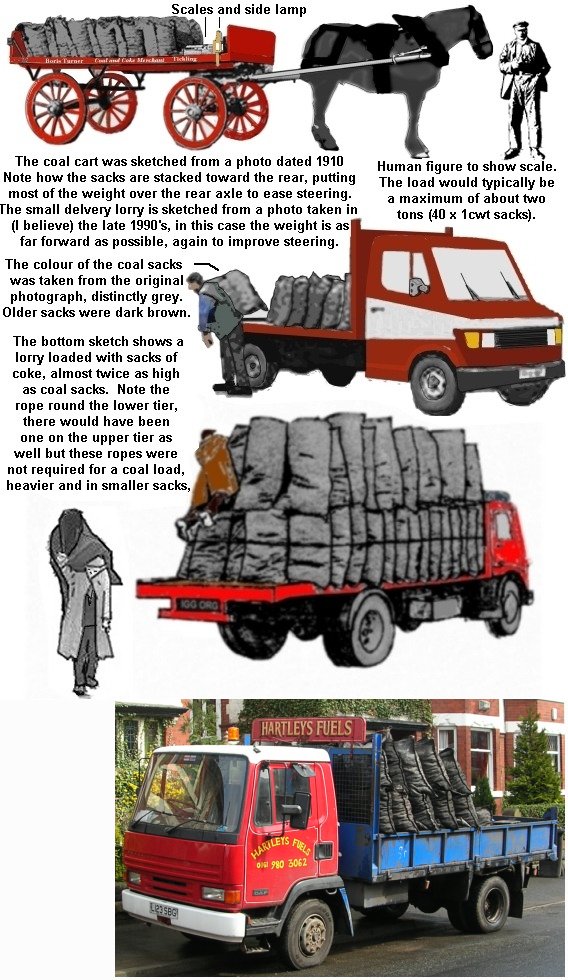
The sketch above is a composite based on several photographs. Note the men delivering coke have no special clothing (see below), just a heavy overcoat for protection from the weather and the heavy sacks
A standard bit of kit for the coal delivery has, since Roman times, consisted of a thick multi-layer leather pad on the back with leather straps passing over the shoulders and secured at the front by a further leather strap. This protects the delivery man not only from the rough abuse of the hard coal lumps but also, possibly more importantly, from the wet rain-soaked material of the sacks. My local delivery lads in the 1950's all wore heavy coveralls, usually with a rather torn woollen pullover on top and a heavy jerkin over that, the jerkin I remember was a modified ex-army sleeveless jacket reinforced with strips of leather on to which the circular steel studs were fixed. I have included a sketch of these jerkins in the illustration below) Mr Hartley (the last independent coal merchant in Altrincham, who appears in the illustration below) tells me that, at least from the 1950's, coal men often wore railway company peaked caps, these were good quality head gear and the railway staff were issued with a new one every year so they sold the old hats to the 'coalies'.
Fig___ Coal men and hundredweight sacks
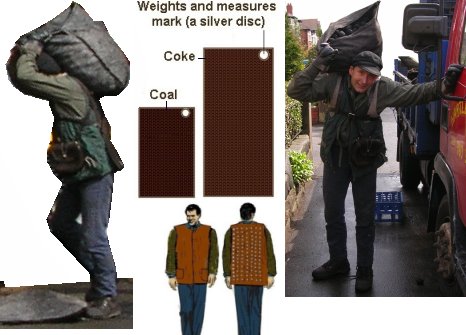
In the days before mechanical coal cutting 'grading' of coal was not quite so stringent, slabs of up to a hundredweight might appear in a colliery wagon, coal hammers (small lump hammers), were carried by the lads to break up big lumps of coal in the wagons. After the war when drilling and trepanning machines came in the big lumps disappeared and a more even if smaller size of coal appeared.
Once in the yard the horse drawn cart or motor lorry would be pulled up close alongside the rail wagon and, when filling sacks on a flat bed, some filled coal sacks were then placed to form a wall around the area where the drop-door of the railway wagon would fall. The railway wagon side door was released and fell outwards onto the floor of the lorry, on the domestic delivery side the delivery man and his mate would use shovels to fill the coal sacks and stack these on the wagon, the trick was to avoid getting the coal on to the floor where it was difficult to shovel up.
In built-up areas a sixteen or twenty ton wagon could easily be emptied in a day, possibly by a single delivery vehicle if the customers were all close by the yard. The lads would load up perhaps 100 sacks, take the loaded wagon out over the weigh-bridge, deliver the coal, return and repeat the exercise again. A good working average for a two man team, at least in the 1950's and using motor lorries for deliveries, was two loads of 90 sacks a day. Up to the 1950's every house on a street would receive a delivery so the turn-round could be quite quick and four or five loads would empty a wagon. In built-up areas the yard might get through between three and five hundred tons of coal a week. Coal rationing introduced during the Second World War gave each house five hundredweight of coal a month (slightly more if the house had no gas or electric stove), which simplified deliveries.
Small factories and the like with no rail connection of their own would take delivery of bulk coal in horse drawn wagons or (from about 1925) increasingly in tipping motor lorries. The horse drawn tip carts were usually small two-wheeler types, the short body was centred above the axle to ease tipping and they were usually fitted with a drop-down tailgate. Coal yards were equipped with a weigh bridge to check the load, bagged or in bulk. As with the domestic deliveries the tip carts would be pulled up close by the railway wagon and loaded with shovels. (Horse drawn vehicles are further discussed in the section on Railway Company Goods Facilities - Goods Yards and Wharfs and in the section on Transport - Roads - Horse Drawn Vehicles.)
In the early 1950's a new type of coal or (more probably) coke lorry was developed. This had what looked like a hopper body but in fact the hopper fed a conveyor which delivered the load to the rear. Attached to the rear of the hopper was a mechanism for weighing the coal and a frame to hold the sack. The delivery man could place the sack on the frame and start the motor. A measured weight of coal or coke would be fed into the sack and a hydraulic mechanism would lift it so he could sling it onto his back.
Fig___ Coke Lorry

I believe these lorries also supplied larger users by emptying directly into the storage bunkers. They were loaded either by reversing them into a coal drop or using a crane equipped with a grab. BR used a wide range of small mobile cranes in their goods and coal yards but as far as I am aware there are no suitable RTR models available. They could also be loaded using a 'front loader' (a tractor with a shovel on the front), these are discussed in more detail below.
In a rail served coal yard there would usually be a stockpile somewhere in the yard, in country locations and in areas outside the North East the storage facilities generally consisted of bunkers made from old sleepers, or more recently 45 gallon steel drums filled with rubble (by the 1990's old car tyres filled with earth were becoming quite common). The steel drums could be stacked three or four high in larger dumps. It should be noted that coal is not piled deeper than about 10 feet as this might lead to spontaneous combustion in the pile, smokeless fuel is less prone to this however so a modern `coal' dump might have this fuel piled quite high. The 'Clean Air Act' was passed in 1956, allowing local authorities to create 'smokeless zones' to try and reduce 'smog' (fog with dirty smoke mixed into it), this brought an increased demand for suitable fuels but severe smogs continued (there was a rather nasty smog in 1962 that killed a lot of people). Smokeless fuels are more fully described below.
In larger yards the stockpiles would usually be set back from the track to allow delivery vehicles access to the railway wagons. In smaller yards the stockpile might be in a series of bunkers close by the track so the wagons could be emptied directly into them, the traders cart or lorry could be loaded as normal from wagons further up the siding. Coal was stockpiled before Christmas as no coal would be supplied for a week or so afterwards due to the holidays. Coal is not a standard commodity, different mines and even different seams in a single mine, produced different qualities of coal. A typical coal merchant would therefore require a series of bunkers in which to store the different types he sold. Also unusual or expensive coals, such as the very hard anthracite, might be stockpiled as demand for these was not great. Generally the bigger the lumps of coal the better the fire burns, so coal from a single mine was always graded by size. Coal stockpiled by a local merchant would have been divided into three piles, based mainly on the size of the lumps of coal, for household, hearth and industrial. Following nationalisation the National Coal Board supplied coal in three standard grades, A, B and C. Best quality coals were Class A, worst were class C. As the size of the lumps was an issue a single class could include small coal that burned well and larger lumps that did not burn quite so well.
Getting the coal to the stock pile was often a laborious exercise. It was not uncommon for planks to be laid across the top of the wagon and across to the coal pile and a wheelbarrow would then be used to transfer the coal. Man power in Victorian and Edwardian days was relatively cheap, and these methods continued in use up into the early 1960's in some yards. Coal conveyors, of the type offered by several American model railway firms, were used in larger British yards from the early 1930's. The railways used them to load railway wagons from a coal heap and larger private traders used them to load coal into delivery vehicles, again from the coal heap in the yard.
Fig ___ Large coal yard behind a passenger station
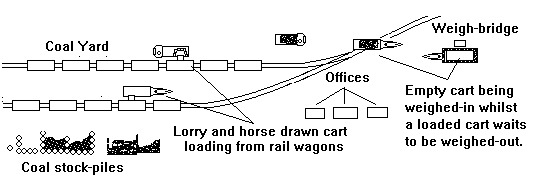
By the 1950's there were very few of the older 8-ton capacity 5-plank private owner railway coal wagons left and these had all gone by the 1960's. By the mid 1960's most domestic coal was moved in BR steel sixteen ton four wheeled mineral wagons, the larger 21 ton types mainly handled industrial users needs.
Coal wagons sometimes had damaged side doors (these would be marked with a large white X), which meant they had to be unloaded through the end or bottom door, a rather dangerous practice by all accounts. The coal would then have to be dug-out from beneath the wagon and either loaded into sacks on the delivery vehicle or shifted to the piles in wheelbarrows. Shovelling from the floor a good man could fill a sack held open on the cart by his mate with four or five shovel full's, each of over 20 lbs. The coal was thrown up and fell into the sack, which required skill as well as strength.
After the second world war horse drawn delivery carts were increasingly replaced by ex war department lorries, typically flat-fronted Bedford's (although my own memories suggest a bonnet fronted Bedford flat bed was used by my local merchant in the 1950's). These ex army lorries often had a circular hatch on the passenger side of the cab roof, perhaps thirty inches across, fitted with a simple flat cover (in army service this hatch had a Bren type machine gun fitted for anti-aircraft defence). If modelling this era a civilian lorry can be 'militarised' by adding a disk of 20 thou card. The introduction of the MOT tests in the later 1960's told against the use of older lorries and further reduced the profit margins for smaller traders. This directly contributed to the closure of a number of smaller coal yards.
The Co-Op operated a number of coal delivery services, the sketch below shows an Ipswitch co-op electric float modified for use as a coal lorry in about 1960, note the rear deck has been raised so that the sacks would be lifted without the delivery man having to stoop.
Fig ___ Electric coal delivery lorry

Prior to nationalisation individual traders bought coal by the wagon load from individual collieries, when the coal industry was nationalised this ended and the National Coal Board arranged deliveries. In talking to coal merchants who operated at that time it is widely reported that the better coals, such as those from Barnsley Main Colliery, were directed to the South East. Another problem was that the nationalised railways were less willing to shunt coal yards following the Freight Train Plan of the later 1960's. A larger yard with perhaps three or four long sidings had originally been shunted twice a day, this went down to once a day and then the railway refused to shunt at all, only collecting any empty wagons that happened to be at the end of the rake. The traders still had to pay demurrage on any wagons retained more than 48 hours.
The trader would supply bagged coal to homes and bulk coal for factories and the like. The sketch below shows an electric conveyor in use in a coal yard for loading bulk coal from the yard stockpiles into delivery lorries in the 1970s.
Fig ___ Coal coveyor-loader
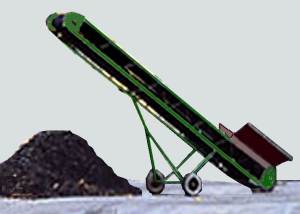
Bottom discharge using hopper wagons or the bottom doors on standard wagons was a feature of railways in the North East, much less common elsewhere although sometimes seen in industrial areas. Bottom discharge requires either an excavated `drop' or a raised section of track run over a set of bunkers into which the wagon discharges. They are often found where the track was conveniently elevated, running along the side of a hill or leading out to cross a river valley. Where there was no suitable natural depression it the North Eastern Railway built ramps leading up to a raised section of track above a row of bunkers. The ramps were commonly earth banks and the clearance under the timbers supporting the track might be as little as six feet. Earth banks take up quite a lot of room so it might be better to make up a timber framed structure as shown in the drawing. Where the lie of the land allowed a siding or two would be run out on a kind of viaduct so the wagons could discharge into the bays beneath.
Fig ___ Coal drops
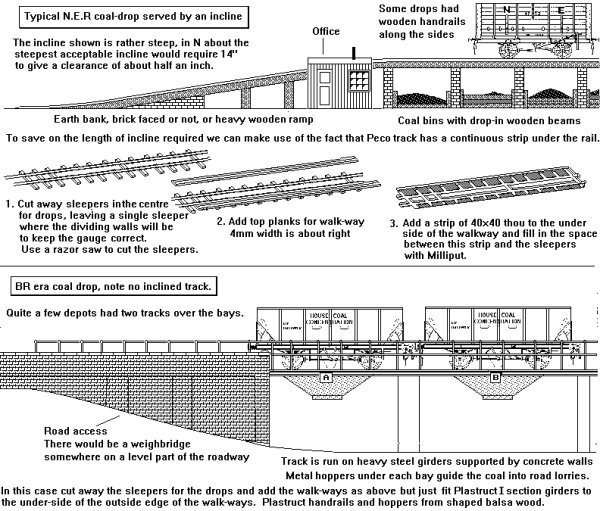
Hopper discharge is easy and economical but coal drops are expensive to build. Under Dr Beeching coal supplies to private siding serving smaller coal merchants were discontinued, being replaced by block train workings to a small number (only 292 nation wide) of specially built `House Coal Concentration Depots'. These were built from about 1965 and all were completed by about 1970, some were operated by BR whilst others were operated by larger coal merchants such as Moy's, Charringtons (now CPL Distribution) and Underwood & Co Ltd. The Bristol Mechanised Coal Company Ltd CCD was built and paid for by a local coal merchant (who later purchased E.H.Bennett & Co.Ltd. who are still trading), opened in 1965 it was at the time the most highly mechanised coal depot in the country. Some CCD's had a surprisingly short life, for example the Wolverton CCD opened in 1967 but in 1972 it closed to become an aggregates terminal for the new town of Milton Keynes, a fate which befell several terminals in later years.
Coal concentration depots do not usually store much coal on site, although a small reserve was always kept on hand. In the depots where coal is stored in some of the bays a mechanical shovel is provided to load the lorries. House coal was delivered mainly in 21 ton hopper wagons but also in a range of other hopper types such as the sand/iron ore hoppers available in simple kit form from the N Gauge Society. Fitted hopper wagons used for this service were often marked `HOUSE COAL CONCENTRATION' on the side (the unfitted wagons may have been similarly marked but I have never seen a photo of one).
Fig ___ BR 21 ton coal hoppers
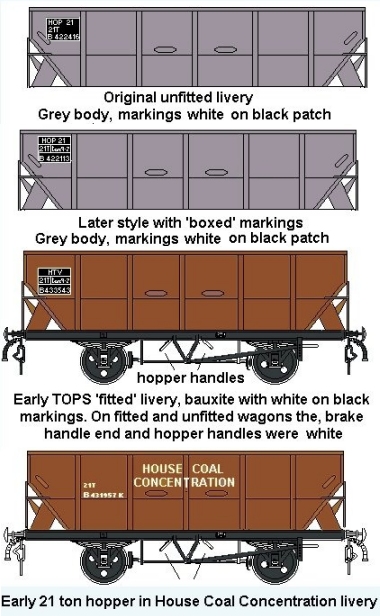
The coal concentration depots supplied local traders with coal either in bulk or ready-bagged for sale, the trader was expected to arrange his or her own transport from the depot to his yard. The plan was to use hopper wagons running over coal drops from where conveyor belts would carry the coal to storage piles and feed large hoppers to load lorries with bulk coal or fill bags for sale to coal merchants. The BR period coal drops were all concrete and steel but the older bunkers of the NER and other companies were usually brick-built (occasionally wood in old privately owned installations). These old drops remained in use at some locations but required mechanical shovels to move the coal to the storage piles.
In practice the actual installations ranged from the new purpose built and highly automated establishments down to a simple paved yard with a few (typically three or four) long siding running into it and served by the standard mineral wagons. In the simple coal yards the traders lorries were weighed in, loaded with coal (either ready bagged or in bulk), and weighed out. The trader would then be invoiced for the coal taken. In some of these flat yards the traders were allowed to pull up beside the wagons and load their own bags direct from the 16 and 21 ton standard wagons, so such a yard would bear a strong resemblance to the old fashioned coal yard behind the passenger station shown above. These simple yards were intended to be a temporary measure but in the event some remained operational into the late 1970's (possibly the early 1980's).
The highly automated type of yard represents a modelling challenge, not least because of the room required but also because of modelling the conveyor system. There were however some yards that fell in between the two, one example being the yard beside Stockport station on the former LNWR line from Manchester to Crewe.
In Stockport the old coal depot had both open sidings on the level for loading road carts and a set of coal drops (I believe these two sets of facilities were operated by different coal merchants but I am not certain on that point). The coal drop served as the coal concentration depot, as far as I am aware it was only ever fed using the old 21 ton hopper wagons (I never saw any HBA/HEA hoppers there). The coal drops were finally demolished in the mid 1980's to make way for a leisure complex however there are a couple of photographs in the Stockport library collection. This structure was built on the side of a hill with concrete supporting walls for the coal cells roughly twenty to thirty foot high and spaced at about twenty foot intervals (there was room for a single HTO/HTV hopper above each bay). Twin tracks were carried along the top supported on steel girders with wooden decking surrounding them so each cell could be supplied with two hopper loads at a time. The tracks over the cell were covered by a simple apex corrugated iron roof (with no sides) supported on metal posts (for a model the Ratio corrugated roof would serve rather well for this).
There was a cast plate about two foot square above each bay marked with a number or letter, 1,2, or A, B etc. This number or letter was also often painted on the dividing bay walls in black paint about eighteen inches high. On reflection the A, B and C plates may have indicated the grade of coal to be discharged into the cell however this would have required a high degree of organisation, not least in shunting the hopper wagons into position. Those I remember were all single-sided, that is the lorries had to back-up into the bay to load, the rear wall extended right up to the track level. These were all located on a hillside however so open drops may have existed elsewhere.
The coal could be loaded into lorries directly from the hopper or shifted from the cells by mechanical shovel. Mechanical shovels were also used to feed 'bagging' hoppers mounted on a raised metal framework with a measuring chute fitted to the base. The base itself was raised to form a platform at the same level as the rear deck of a delivery lorry. In a few locations the coal cell itself held a hopper and measured bagging device but these seem to have been the exception rather than the rule.
Coal bagging hoppers used by smaller traders were themselves usually quite small and you can get away without doing too much work as the lorry-loading side was often covered with a corrugated iron roof to prevent spills from the hopper loading operation injuring the men on the lorry. This was not the case at my local yard where the hopper was in the open. The hopper had a chute below to feed the bag, this had the measuring tackle and a lever to operate the doors on the hopper bottom and chute alternately. The bag to be filled sat on some kind of mechanical plate (possibly a scale and possibly connected to the chute lever) which itself sat on a raised wooden floored platform, the same height as the bed of the delivery lorry (about four feet up) to ease loading of the vehicle. I tried to find one from which to make a sketch but the smaller type now seem to have gone, the Historical Model Railway Society holds a photograph of a disused and overgrown example in their collection.
The early mechanical shovels were not the familiar JCB type, mainly because early hydraulic systems were unreliable (the seals were the main problem). Mechanical shovels in the 1950's and early 1960's were usually a modified standard agricultural tractor. These were equipped as standard with a 'power take off', usually on the lower right of the engine and this could be fitted with a winch drum. A rectangular metal frame was bolted to the chassis with a pulley system hanging from the top. The shovel was mounted on a pair of rigid arms and these were lifted and lowered by a wire linked to a winch drum. I think the bucket was actually tipped by a mechanical lever but I am not sure about that. The size of the 'bucket' was small by modern standards, holding about as much as a wheelbarrow I believe.
The sketch below left shows a Chaseside loader attachment fitted to a Fordson tractor. This was a popular system, first introduced in 1937 (when the Chaseside Engineering Co Ltd of Enfield, Middlesex was formed) and remaining in production until 1945 (Chaseside continued in existence until 1965). These were sturdy machines and remained in use well into the 1960's. The sketch is based on an advertisement for a 7 mm scale kit of the machine offered by Classic Commercials (Classic Commercials, PO Box 800, West Wratting, Cambridge CBl 5NB, UK). The machine I saw was rather less sophisticated and may have been a home made machine. The sketch below right shows what I remember as the arrangement, the rectangular frame was all I section steel, the central pulley at the top linked to one on the side which fed the cable down to the winding drum. This sketch is provisional and may be incorrect in detail, somewhere I have a photograph, when I find it I will re-do the drawing.
Fig ___ Early mechanical shovels

It is perhaps worth noting that the size of all motor vehicles has increased considerably over the years. A coal merchants delivery lorry from the 1950's is actually not much larger (if at all) than a modern four wheel drive all-terrain 'shopping' vehicle. This is handy when modelling as the space required between tracks to allow the model lorry access is quite small. The illustration below is not actually a coal merchants lorry but this type of vehicle fitted with a flat bed rear was used for that purpose and tippers of this design were used for bulk deliveries of coal. The vehicle is a Bedford O type from about 1949, the figure is to a scale height of about six foot to show the size of the lorry (a better illustration will be produced in due course).
Fig___ A 'big' lorry from the 1950's

As hydraulics became more reliable the more modern 'JCB' type shovels were introduced in the late 1960's and by the late 1970's much larger purpose built machines were in regular use. These had considerably more power than had been available on older machines and the bucket with which they are fitted is correspondingly larger. Similarly the hoppers these machines feed have increased in size, the bagging hopper at my local coal merchant's yard in the late 1960's was about eight feet wide and six feet from front to back. It was about six feet deep (two feet high sides with a four foot deep hopper beneath) and stood of four legs which held the base of the hopper about five feet above the platform. The bagging arrangement was below this, extending down to a plate on which the sack rested during filling. The platform was in turn about four feet off the ground, slightly higher than the deck of the lorry he was using. A modern hopper is a much larger affair, often supported on a substantial brick or concrete three sided box wall perhaps thirty feet square and fifteen feet high supporting a hopper six feet high. A standard JCB type tractor cannot reach high enough to load these hoppers, and the bucket is rather small for the job. Even in a small yard the size of hopper seems to have increased and where standard front-loader tractors are used an earth bank ramp is provided to get them up high enough to load the hopper.
In the 1960's a four wheeled crane with a long jib was based in the coal yard serving the built up area around Altrincham. Some seven traders operated from this yard at that time and there were several 'coal heaps' around the sides of the yard surrounded by old sleepers on end and walls of oil drums. I believe the crane had a grab attachment, although whether this was used to unload the mineral wagons, load lorries with bulk coal or both I am not sure.
Fig___ Coles crane as used at Altrincham
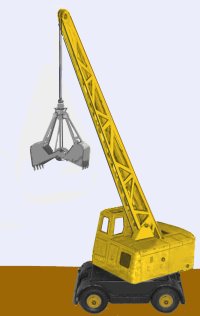
Although Dr Beeching's new coal concentration depots offered coal ready-bagged as well as in bulk this system proved to be somewhat unpopular as the merchants preferred to bag their own coal. The coal trader had to make his own arrangements for road delivery to his own depot, this meant many traders simply switched to road delivery direct from the NCB. They did tend to continue to use their existing premises however, although as they favoured bulk deliveries mechanical handling was introduced in most coal yards during this time. In my youth I lived in a relatively rural area. The coal trader operated from my local station and made deliveries for about four or five miles maximum. In the 1950's and 60's, three or four 16 ton mineral wagons would normally be found on the single siding behind one of the platforms, which also served for any goods arriving at the station. There was a small stockpile set back from the track across the yard. He had a mechanical shovel and coal bagging hopper in the yard and when BR decided he no longer warranted a rail delivery to the yard he switched to bulk delivery by road, again bagging the coal himself.
With the decline of coal as a domestic heating the coal drops at redundant coal concentration depots were often pressed into service for shipping other materials such as sand and gravel. In 1982 there was a major reorganisation of railway coal services with a dramatic reduction in the number domestic coal concentration depots, less than a hundred remaining in service. Some of the redundant coal drops were then used for unloading crushed road stone from PGA 50 ton hopper wagons.
Speedlink Coal was the first Railfreight business to be sectorised, a process completed in early 1988, it dealt with mined coal and processed `smokeless fuels' in hopper wagons or the newer four wheeled container (e.g. Cobra) type wagons. The use of the container wagons is discussed in Freight Operations - Air Braked Containers - Non Freightliner, the terminal equipment is described in the section on Railway Company Goods Facilities - Container Handling.
The introduction of Speedlink Coal saw a greater emphasis on the use of private yards and there is a machine called an 'over rails under loader' which allows hopper to be used without a 'drop'. This is a mobile unit, rather resembling a farm elevator, which is slipped under the wagon and feeds the coal up into road lorries or onto a stockpile. In the late 1980's occasional wagon loads of coal became less of a feature of the mainstream Speedlink trains with the introduction of a separate Speedlink Coal Network, specialising in block train coal deliveries to domestic distribution depots and smaller industrial users. This service was abandoned with the end of Speedlink in the early 1990's but services for larger customers who required viable train-load deliveries were maintained.
Types and grading of coal and smokeless fuels
Some notes on the appearance of coal might be of interest. According to my local coal merchant (Mr Hartley of Hartley's Fuels in Altrincham) small coal was graded into a range of sizes, 'dingles' or 'peas' were about the size of a thumbnail, 'singles' were twice that size, 'double' were about an inch by two inches, trebles were around three inches by two inches, cobbles were perhaps four inches by two inches and large cobbles were around six inches by three inches. Each wagon carried a proportion of crushed coal, small lumps and dust, commonly called 'slack'. This stuff was useful for banking-up a fire so it would burn all night but it could not command a high price, so the lads would try and make sure each sack carried a proportion of the slack. Nutty slack, the butt of so many music hall jokes, was the residue left at the bottom of the pile of better quality coal, comprised of small bits of coal (the nuts) and dust (the slack), this was sold cheaply for household use. Welsh Anthracite coal is the highest quality, it is hard so tends to stay in larger lumps, it burns hot and is virtually smokeless (it has few impurities and is almost pure carbon). Gas works required coal with a high hydrogen content but could make good use of smaller coal. This fused together during the gas making process and the resulting coke was sold for use as fuel (it was not suitable for iron and steel making as it contained too many impurities). The smaller bits of coke (or breeze) were usually separated by a screen and used to fire the retorts at the works. Gas works coke was popular for use in boilers, this may have been dependant on the industry involved or it may simply have been because it produced less soot (the early railway locomotives on the Liverpool & Manchester Railway used coke as fuel as it burned better than the available coal in their primitive boilers and produced less smoke). It was sold for domestic use as a 'smokeless fuel' and factories used it to make 'water gas' and 'producer gas' (both are basically carbon monoxide gas which was burnt to produce carbon dioxide - See Appendix One - Fuels for further information).
In response to the smog of December 1952, which killed about 4,000 people in and around London, the Clean Air Act was introduced in 1956. This act allowed local councils to ban the use of bituminous coal and insist people switch to 'smokeless fuels' for domestic heating. The market demanded 'smokeless fuel' and gasworks coke (marketed as Firemax) was a popular choice up to the early 1970's when the country switched to North Sea Gas. There had existed a demand for smokeless fuels, gas works coke and Welsh Anthracite were both sold in the pre-war era as being 'smokeless fuel', however gas works coke was not that plentiful and anthracite was expensive so a range of alternatives were produced, usually compressed into lumps about the size of a bar of soap. Coalite was first to market, followed by Rexco, both being essentially coke ground to a powder and mixed with coal tar. Phurnacite is a blend of anthracite and ordinary coal, Sunbrite, Roomheat and Homefire are (I believe) coke based products. As they are (mainly) coke based and hence lighter than normal coal the wagons used for smokeless fuel were sometimes fitted with 'coke rails', given the numbers available and the demands of the steel industry I suspect the BR operated high capacity coke hopper wagons were not used for smokeless fuels but I believe the standard 21 ton hoppers were used.
The country was in difficult financial times when the clean air legislation was introduced and smokeless fuel cost about half again as much as regular coal. Due to its cost and shortness of supplies railway locomotives were exempted from the rules, pressure from the nationalised waterways meant that the canal boats were also exempted (technically any fire which moves is exempted). Coal and smokeless fuels (which these days often produce less ash) have remained popular where mains gas and electricity are either unavailable of inconvenient, notably on canal boats and for heating caravans. Coal and smokeless fuels are often seen as 'inconvenient', the coal has to be brought in in a bucket and a residue of perhaps eight percent ash has to be removed, but they offer certain distinct advantages over alternative heating fuels. Coal produces a dry heat, making it suitable for canal boats and caravans. Calor gas and paraffin stoves, the main rivals, produce a lot of condensation (roughly a pint of water for every pint of fuel burned), this may be acceptable in summer but in winter the condensation can get rather unpleasant. In the home a coal fire brings with it a degree of ventilation, reducing the levels of fungal spores in the air, the trend towards central heating and double glazing has seen levels of these spores rise dramatically with an attendant increase in chest complaints.
British deep mined coal is now rare following the mass pit closures of the 1970's and 1980's, most deep mined coal is imported (Mr Hartley advises that the best quality he has to offer is currently a Colombian coal, imported from South America). Most British produced coal is these days recovered from shallow open cast mines and as it has not been compressed it is more likely to fall into small pieces and dust. Although acceptable for power station use this is less than ideal for domestic users and the convenience of the smokeless fuels has seen these increasingly used for canal boats and the like.
